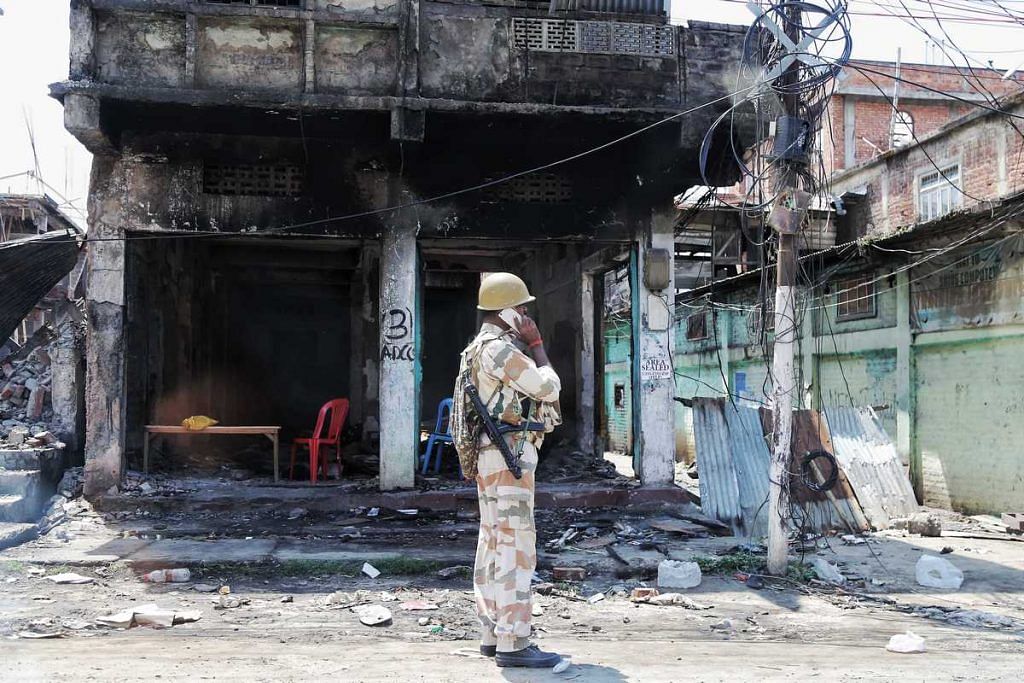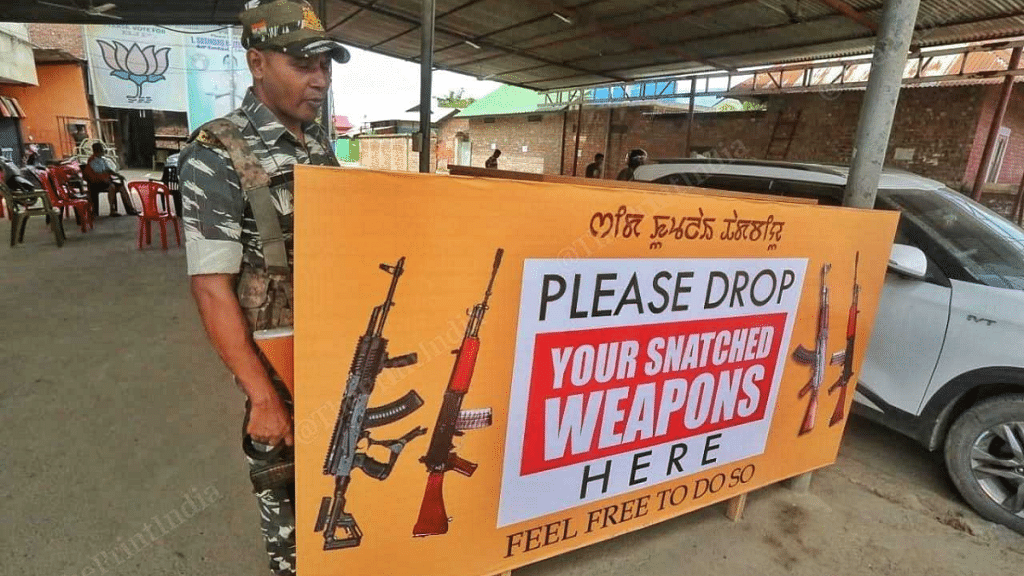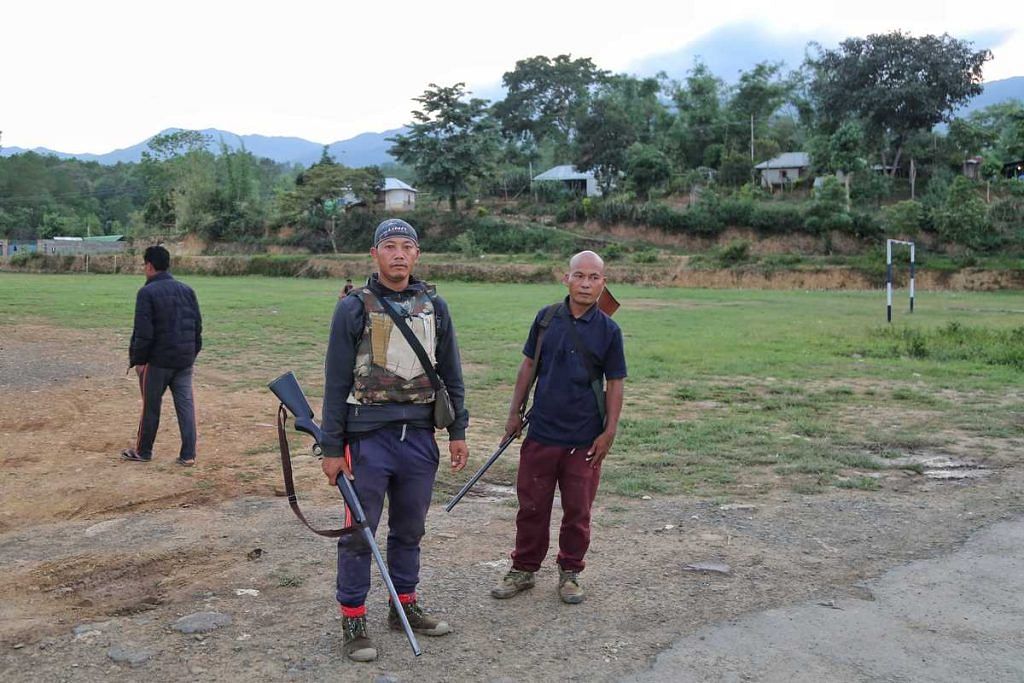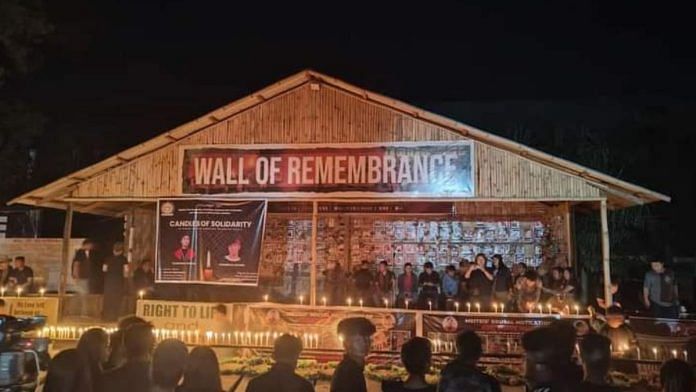New Delhi: One year after violent clashes erupted between the Kuki and Meitei communities in Manipur on 3 May 2023, the state continues to grapple with a ruptured social fabric, a “volatile” law-and-order situation, and a large number of looted firearms still circulating among civilians and in the black market, according to security and police sources.
Over the past year, more than 200 lives have been lost, over 60,000 people have been displaced, and there have been multiple incidents of violence against women. Despite efforts to restore peace, the state is still a tinderbox even if it has largely faded from the news. Vigilante groups continue to operate with impunity, security forces face frequent attacks from locals, and the stolen weapons from police armouries pose a security risk.
Data obtained by ThePrint shows that as of 1 May 5,682 firearms were looted from police armouries and stations, primarily in the Meitei-dominated Imphal Valley. However, only 2,030, or 35.7 percent, have been recovered so far. Additionally, out of the 6.64 lakh rounds of ammunition stolen, only 28,000—a mere 4 percent—have been traced. This suggests that a significant arsenal still remains with local people.
Security personnel claim that the continuing outbreaks of gun violence in Manipur are largely perpetrated by locals using stolen service weapons—including AK-47s, carbines, INSAS rifles, and light machine guns—as evidenced by the types of cartridges used, firing patterns, and the extent of damage inflicted.

A senior Manipur police officer said that the weapons in circulation and tacit support of the public to armed miscreants are big challenges for the forces.
“So many sophisticated weapons are still under circulation in the market and that is a big challenge,” he said.
According to police data, as of 1 May, 11,150 FIRs have been registered in connection with the violence. Authorities have arrested 495 individuals, with an additional 4,15,000 placed under preventive arrest. The data also shows that 1,559 people have been injured in separate incidents of violence over the past year, while another 30 are currently missing and presumed kidnapped or murdered.
Speaking to ThePrint, Director General of Police Manipur, Rajiv Singh said that the incidents of violence have reduced but the situation still remains unstable.
“The spread of violence, including cases of arson and murder, have come down but the situation still remains volatile, so the police are keeping a close watch,” he said.
Singh added that despite challenges and sporadic incidents of violence, “tremendous cooperation between the state police and different central forces has helped control the situation”.
However, the renewed activity of “underground groups”, usually just referred to as UGs, over the past year has created new obstacles to normalisation.
Also Read: Manipur violence has a silent victim—broken marriages of Kuki-Meitei couples
Entry of insurgent groups, arms in black market
A major hurdle in recovering looted weapons and ending the cycle of violence in Manipur is the resurgence of armed UGs, primarily in the Meitei-dominated Imphal Valley. Here, armed groups are known as VBIGs (valley-based insurgent groups) have become very active.
“This is because the public support is now with them,” a second Manipur police officer said. He added that because of this, people are no longer sharing intelligence and the security threat is further exacerbated by the sale of weapons in the black market.
“Whatever minimal recovery done by the police is with the help of surveillance and checks while most of the raids are not yielding results,” the officer said.

The weapons looted include 245 AK 47s, 250 machine guns, 1,600 Self Loading Rifles, 1,060 .303 rifles, 973 INSAS rifles, 630 carbines, 130 Light Machine Guns and 220 pistols. As of now, among these, only 85 AKs, 200 INSAS, 35 LMGs, 350 SLRs, 270 .303 rifles, 240 carbines, 8 MP5s, 90 pistols, 8 revolvers and 8 M16 rifles have been recovered.
In the Imphal area, VBIGs that had previously been pushed out from Manipur and then stationed in Myanmar’s jungles. They have come back to Manipur to fight for their community and train recruits, while also engaging in extortion and weapons trafficking, the officer added.
Intelligence reports suggest an infiltration of approximately 200 to 250 VBIG cadres into Manipur.
“They realised that (the conflict) was an opportunity for them to re-establish themselves and they have now taken over ground,” the officer said.
Recruitment of ‘volunteers’, extortion
In both hill and valley areas, sources said, there has been a concerning rise in the recruitment of civilians, especially youth, into armed groups as “volunteers” and “fighters”. These youngsters join both reactivated underground insurgent groups and newly formed radical outfits, all armed with sophisticated weapons, adding fuel to an already combustible situation.
According to Intelligence sources, many young students, office workers, and small business owners are taking up arms. Some become “village defence volunteers”, while others join insurgent groups after training to “protect their community”.

Data available with the security forces shows that the strength of Arambai Tenggol, a radical Meitei group, has shot up considerably. As of March 2023, the group had only 7,000 members. However, its numbers have grown by almost 614 percent, reaching an estimated 50,000 people spread across 59 units, as of March 2024.
For the Kuki groups, the numbers have remained more stable as these fall under the Suspension of Operations (SoO) agreement and their camps are checked every month to ensure that they are inside, the second officer said.
“This, however, does not mean that these groups are not going out of the camps in violation of rules,” he cautioned. “There are inputs of these cadres indulging in extortion along highways and also training village defence volunteers that they have informally inducted, if not recruited in their ranks.”
Despite many allegations of violence, looting, and arson attacks on churches during the ongoing ethnic conflict, Arambai Tenggol enjoys some popular support for “resisting” external forces. In January, the group gained notoriety for summoning MLAs to Kangla Fort for a meeting and allegedly compelling them to sign a draft proposal and swear an oath to to “protect the integrity of the state”.
Security sources also report an increase in recruitment across various VBIGs, including the People’s Liberation Army (PLA), factions of the People’s Revolutionary Party of Kangleipak (PREPAK), the Kangleipak Communist Party (KCP), the Kanglei Yawol Kanna Lup (KYKL), and factions of the United National Liberation Front (UNLF).
Sources said that these groups are now allegedly involved in extortion activities within the Imphal Valley on the pretext of “protecting” the community from “Kuki militants”.
“These groups are asking for money to fund the fight against the enemy community. Those unable to give money are asked to send young men to join the fight as volunteers,” the second officer said.
Explaining their modus operandi, he added that they scare people by claiming that Kuki militants have come from Myanmar are a threat to security. They then pressure people into giving them money (framed as donations) to acquire more weapons or provide manpower for the frontline.
Also Read: ‘Ignored & forgotten’ or ‘base of live insurgency’ — inside a Manipur SoO camp for Kuki insurgents
‘Dialogue is imperative’
While security forces remain in firefighting mode, little has been done to bridge the divide between the two communities through dialogue.
Last year, Union Home Minister Amit Shah announced a committee with representatives from various ethnicities, political parties, and civil society to initiate dialogue, but the initiative stalled.
While the Kukis are demanding the creation of a separate administration encompassing the Kuki-Zomi-Hmar dominated areas, Meiteis counter with demands for delisting Kukis from Scheduled Tribe (ST) status. They allege that Kukis are assisting insurgents based in Myanmar to infiltrate into Manipur. Meiteis also call for the suspension of the Suspension of Operations (SoO) agreement with the Kukis.
However, a political solution through dialogue is essential for restoring normalcy in Manipur, according to Manipur security adviser Kuldiep Singh.
“The negotiations between the communities have not happened and that is imperative for a long-term solution,” he told ThePrint.
While the incidents of violence have lessened, the situation is likely to remain tense unless both sides come to a consensus at the negotiating table, he reiterated.
“From the security point of view, the police and forces are holding the ground to ensure no violence happens, but a dialogue between the communities is what is required,” he said. “We hope that after the completion of Lok Sabha polls, that will be taken up by both sides on priority.”

(Edited by Asavari Singh)



